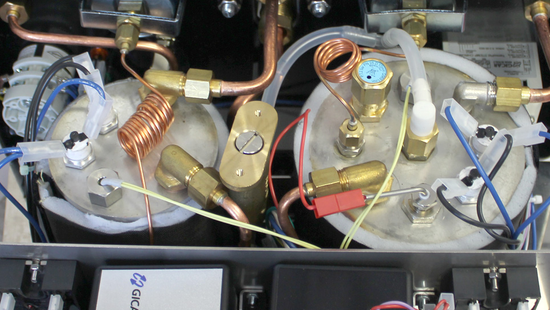Espresso Machine Types, by Boiler

Straight espresso is only one use of the overall espresso machine - especially machines designed for the American market. Equally as important is richly textured milk, used to make cappuccinos or lattes. To get milk textured and hot, machines need steam. In order to produce steam, water needs to be boiled. However, coffees brew best at temperatures well below boiling (195°-205°F). The following are the four ways different machines solve the problem of keeping some water boiling and other water at a lower temperature:
In Single Boiler machines, the boiler has one heating element with two thermostats. One thermostat is set for a temperature range that is ideal for brewing coffee. The other is set at a temperature meant to boil water and produce steam.
Since this is a pretty simple build, machines in this category tend to be relatively low cost. There are two big drawbacks. The first: you cannot pull shots and steam milk at the same time. The second: you’ll always have to wait for the water to come to the correct temperature when changing from espresso to steaming and vice versa.
In order to pull shots and steam milk at the same time, a machine needs to be able to have a way of heating water to two different temperatures.
One solution is a Heat Exchanger machine. Instead of using a boiler to heat water for both brewing and steaming, the water in the boiler is only used to make steam. An additional water line is run from the pump, which then connects to a copper tube, or heat exchanger, that passes through the body of the boiler. The steaming water in the steam boiler heats the water in the heat exchanger without bringing it to a boil. In this style of system, the brew water will never come in direct contact with the boiler water.
A Heat Exchanger offers some benefits over a Single Boiler. Because the brew water is separate from the steam boiler, the machine is able to steam milk and pull shots simultaneously. Unfortunately, the temperature of the brew water is harder to control with a heat exchanger. The brew water in the exchange coil can overheat if left too long. This is why it’s important to bleed or purge a small amount of water immediately before brewing an espresso with a heat exchanger, a practice called temperature surfing.
Another option is a Thermoblock machine. A thermoblock is a thick piece of metal with a small coil machined into it; the whole block is heated by a built-in heating element. Small bursts of water are sent from the pump through the coil; these bursts are rapidly heated to past boiling, turning them into steam. There is still a separate brew boiler, but since the steam and brew water are heated separately, the machine is able to do both at the same time.
For machines aimed to make high volumes of drinks with the requirement of steaming and brewing at the same time, the solution is a Dual Boiler. In this style of machine, the pump sends water to two separate boilers. One heats water to boiling; the other heats water to brew temperature. Most dual boiler machines feature a PID or Digital Temperature Controller, so temperatures for both boilers can be carefully controlled.
Because of the extra boiler and heating elements, these machines will have a higher price point. The advantage is the ability to produce plenty of drinks with significantly higher control and consistency of espresso and steam.
-
Single Boiler
- Pros: Inexpensive
- Cons: Lack of precise temperature control, inability to brew and steam simultaneously, long wait times
- Recommended Machine: ECM Classika
-
Heat Exchanger
- Pros: Less expensive, can brew and steam simultaneously
- Cons: Lack of precise temperature control, requires a cooling flush
- Recommended Machines: ECM Mechanika V Slim, Profitec Pro 500
-
Thermoblock
- Pros: Less expensive, can brew and steam simultaneously, more temperature control of brew water
- Cons: Not recommended for producing lots of drinks or large milk drinks
-
Dual Boiler
- Pros: Can brew and steam simultaneously, precise temperature control, the most consistent brew and steam temp
- Cons: More costly
- Recommended Machine: LUCCA A53 Mini, Profitec Pro 700
Learn more about the inner workings of your machine in our How Do Espresso Machines Work blog post.